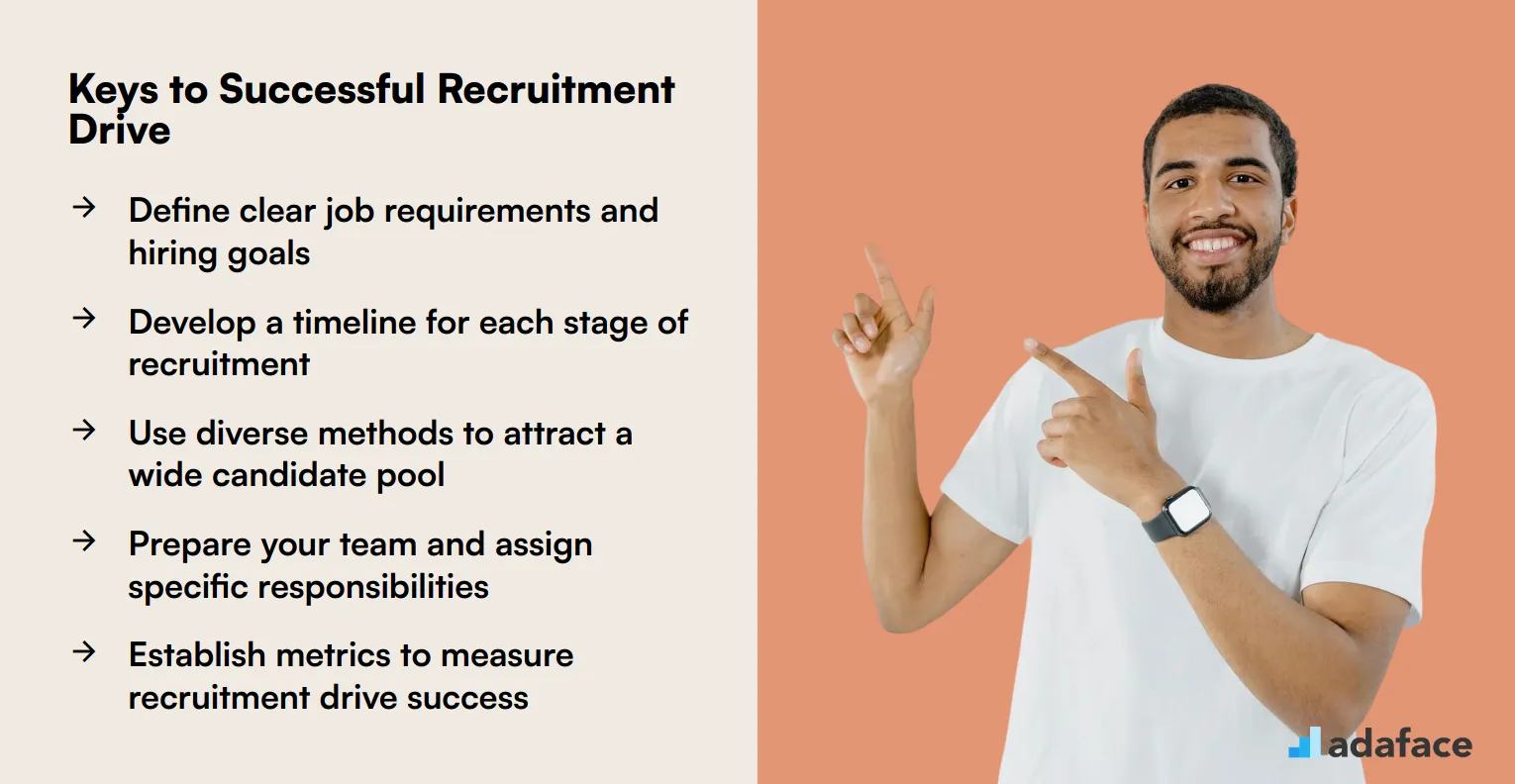A recruitment drive is like a hiring party! It's when companies try to fill many open positions quickly, often using focused and intensive efforts.
Think of it as leveling up your talent acquisition game. A well-planned drive can bring in a bunch of qualified candidates in a short amount of time; helping you meet your hiring goals.
Table of contents
Recruitment Drive Glossary for Recruitment and HR professionals
A recruitment drive is an organized effort to attract and hire a large number of employees within a specific timeframe. Understanding recruitment drive terminology helps interviewers streamline the hiring process and communicate effectively with candidates and stakeholders.
Imagine your company is opening a new office and needs to hire 50 new employees in the next quarter; a recruitment drive, with its own specific jargon, will be launched to achieve this goal, and you need to be ready to ace it! Prepare with Adaface's skills assessments to make the best hiring decisions.
What is a recruitment drive?
A recruitment drive is a focused effort by an organization to attract and hire a large number of candidates within a specific timeframe. It's typically conducted to fill multiple positions quickly, often due to business expansion, seasonal demands, or the launch of new projects.
These initiatives can range from campus recruitment events to large-scale job fairs or online campaigns. They often involve a streamlined hiring process, with on-the-spot interviews and quick decision-making to secure top talent efficiently.
Recruitment drives require careful planning and coordination among HR teams, hiring managers, and other stakeholders. This includes defining clear job requirements, preparing assessment materials, and ensuring a smooth candidate experience throughout the process.
The success of a recruitment drive is measured by the number of quality hires made and the time-to-fill positions. Effective drives can significantly boost an organization's workforce in a short period, helping to meet urgent staffing needs.
However, it's important to balance speed with thoroughness to maintain hiring quality. Organizations must ensure their assessment methods are robust enough to evaluate candidates effectively, even in a high-volume hiring scenario.
Planning your recruitment drive
Planning a recruitment drive involves several key steps to ensure a smooth and effective process. Start by clearly defining your hiring goals and the specific roles you need to fill, which helps align your recruitment efforts with your company's objectives.
Next, develop a timeline that outlines each stage of the recruitment process, from advertising job openings to conducting interviews. This timeline will help manage expectations and keep everyone involved on track.
Consider the recruitment methods you will use to attract candidates, such as job boards, social media, or employee referrals. Diversifying your approach increases the chances of reaching a wider pool of potential applicants.
Additionally, prepare your team by assigning roles and responsibilities to ensure everyone knows their part in the recruitment process. This includes training interviewers to maintain consistency and fairness during candidate evaluations.
Finally, establish metrics to evaluate the success of your recruitment drive, such as the time-to-hire or quality of hire. These metrics provide valuable insights into the effectiveness of your strategies and highlight areas for improvement.

Sourcing candidates for your drive
Sourcing candidates effectively is the backbone of any successful recruitment drive. It's about finding the right talent that aligns with your company's values and needs.
Start by understanding the specific skills and qualities you need in a candidate. This will help you tailor your search and reach out to potential candidates who fit the bill.
Utilize various platforms such as job boards, social media, and professional networks. Each platform offers unique advantages and can help you tap into different candidate pools.
Consider leveraging technology like sourcing tools to streamline your process. These tools can help you identify and connect with potential candidates more efficiently.
Engage with passive candidates by showcasing your company's culture and growth opportunities. This can be achieved through personalized communication and highlighting your employer branding.
Finally, maintain a talent pipeline to ensure you have a ready pool of candidates for future openings. This proactive approach can significantly reduce your time-to-hire and improve overall recruitment success.
Screening and shortlisting applicants
Screening and shortlisting applicants is like sifting through a mountain of resumes to find the golden nuggets. It's the initial process of evaluating candidates to determine who moves forward in the hiring journey.
Think of screening as your first filter. You're quickly reviewing applications to see if candidates meet the minimum qualifications for the job.
Shortlisting is the next step where you create a smaller, more qualified pool. This involves a deeper dive into resumes, cover letters, and maybe even initial phone screenings to identify the best-fit candidates. This is where you can use resume screening tools to help.
The goal is to narrow down the applicant pool to a manageable number of candidates who have the skills, experience, and potential to succeed in the role. This process saves time and resources by focusing on the most promising individuals.
Conducting interviews during the drive
Conducting interviews during a recruitment drive requires a structured approach to ensure consistency and fairness. This process involves preparing a clear set of criteria and questions to evaluate candidates effectively.
Interviewers should be trained to avoid biases and focus on assessing the candidate's skills, experience, and cultural fit. Utilizing structured interviews can help in maintaining objectivity and improving the quality of hire.
It's important to create a welcoming environment for candidates, allowing them to showcase their true potential. This can be achieved by explaining the interview process clearly and providing candidates with an opportunity to ask questions.
Taking notes during interviews is crucial for remembering key points about each candidate and facilitating better decision-making later. These notes can be used to compare candidates against each other and the job requirements.
Finally, timely and constructive feedback should be provided to candidates, regardless of the outcome. This not only enhances the candidate experience but also strengthens your employer brand.
Evaluating and selecting final candidates
Evaluating and selecting final candidates is a critical step in the recruitment process. This stage involves assessing applicants' skills, experience, and cultural fit to ensure they align with the organization's goals and values.
To make informed decisions, hiring managers often rely on a combination of interviews, assessments, and reference checks. These methods provide a comprehensive view of the candidate's abilities and potential contributions to the team.
Interviews, whether structured or unstructured, play a significant role in understanding candidates' problem-solving skills and interpersonal abilities. Structured interviews, in particular, help minimize bias and ensure consistency in evaluating all candidates.
In addition to interviews, pre-employment assessments can be used to measure specific skills or competencies required for the position. These assessments offer objective data that can support the final decision-making process.
Finally, conducting thorough reference checks allows employers to verify the candidate's past performance and reliability. This step helps confirm that the candidate's qualifications and character align with the expectations of the role.
Wrapping Up Your Recruitment Drive
Recruitment drives are a marathon, not a sprint, needing careful planning and execution. We hope this glossary equips you to navigate the process smoothly!
Remember, every interaction is a chance to showcase your company culture. Make it count and happy hiring!
Adaface can help streamline your screening process, freeing you to focus on connecting with top talent. Explore our solutions and make your next recruitment drive a success!
Recruitment Drive FAQs
A recruitment drive helps fill multiple positions quickly, reduces time-to-hire, and can improve employer branding. It's a great way to find talent when you have many openings.
Use social media, job boards, your company website, and employee referrals. Consider creative recruitment campaigns to attract more attention.
Managing a large volume of applications, maintaining candidate experience, and ensuring fair hiring practices can be tricky. Having a good screening process helps.
Keep candidates informed about their application status, provide timely feedback, and make the application process user-friendly. Candidate nurturing is key.
Track time-to-hire, cost-per-hire, number of applications received, and quality-of-hire. These recruiting metrics help you measure the drive's success.
Maintain open communication, provide realistic job previews, and respect candidates' time. A positive candidate experience reduces the likelihood of recruiter ghosting.

40 min skill tests.
No trick questions.
Accurate shortlisting.
We make it easy for you to find the best candidates in your pipeline with a 40 min skills test.
Try for freeRelated terms



